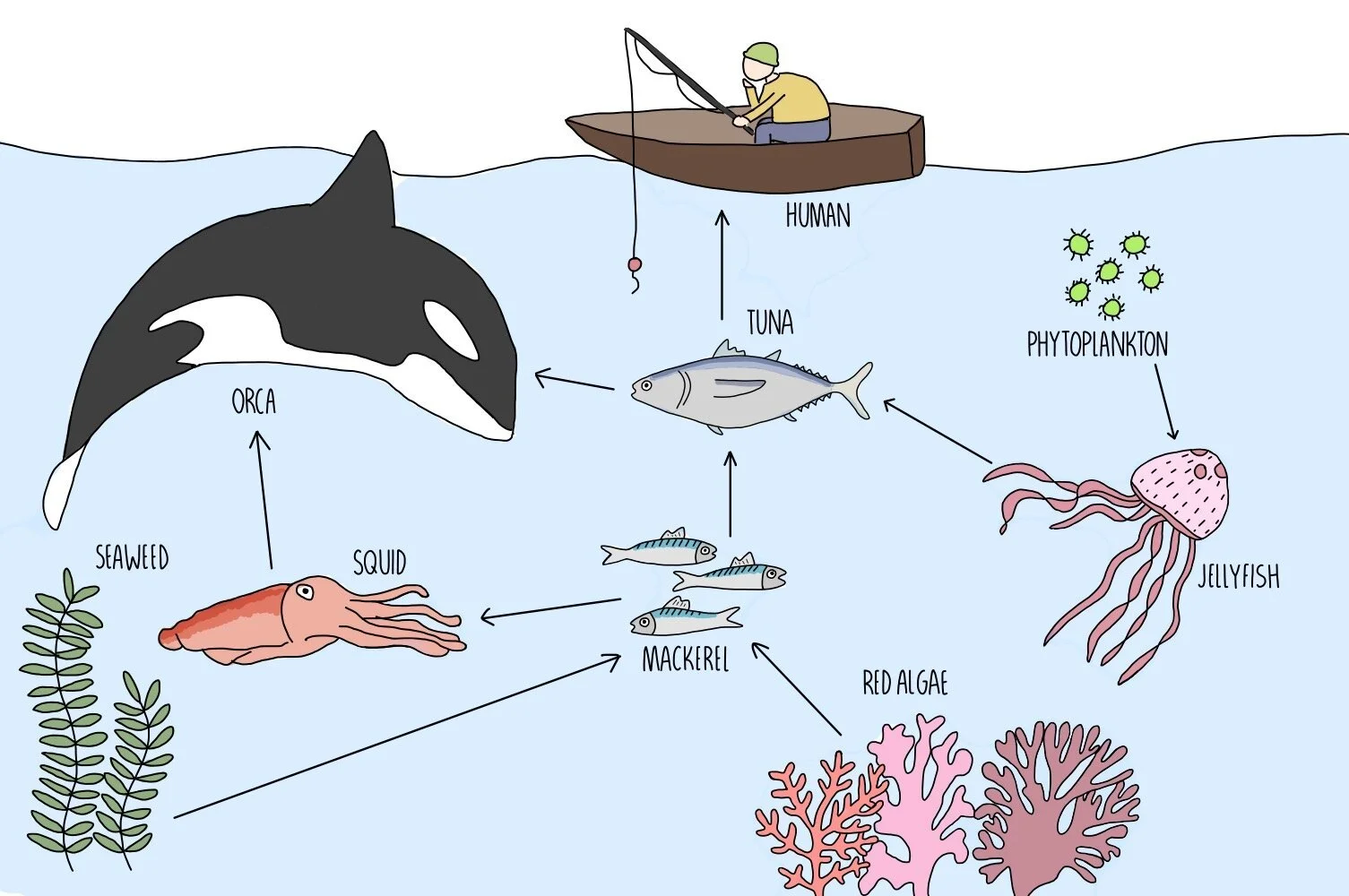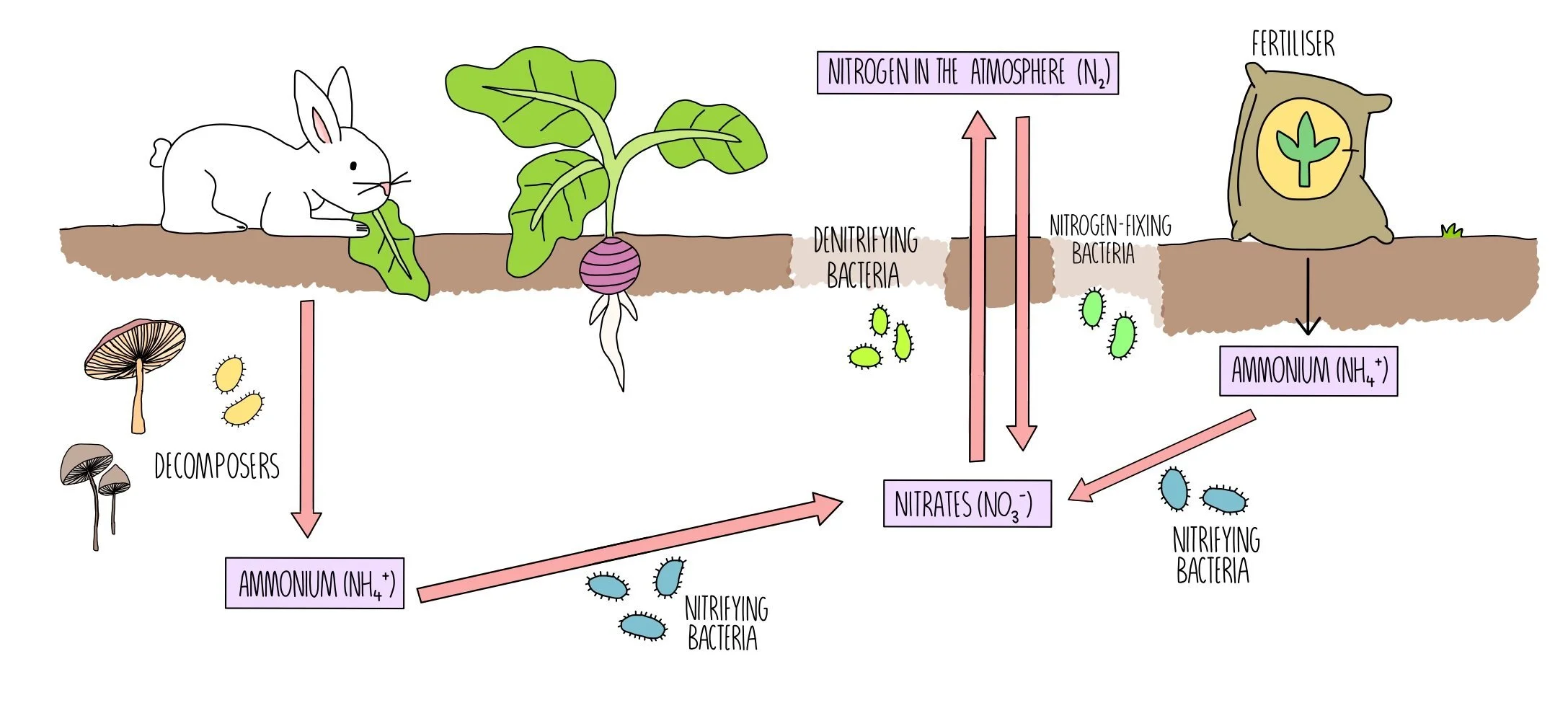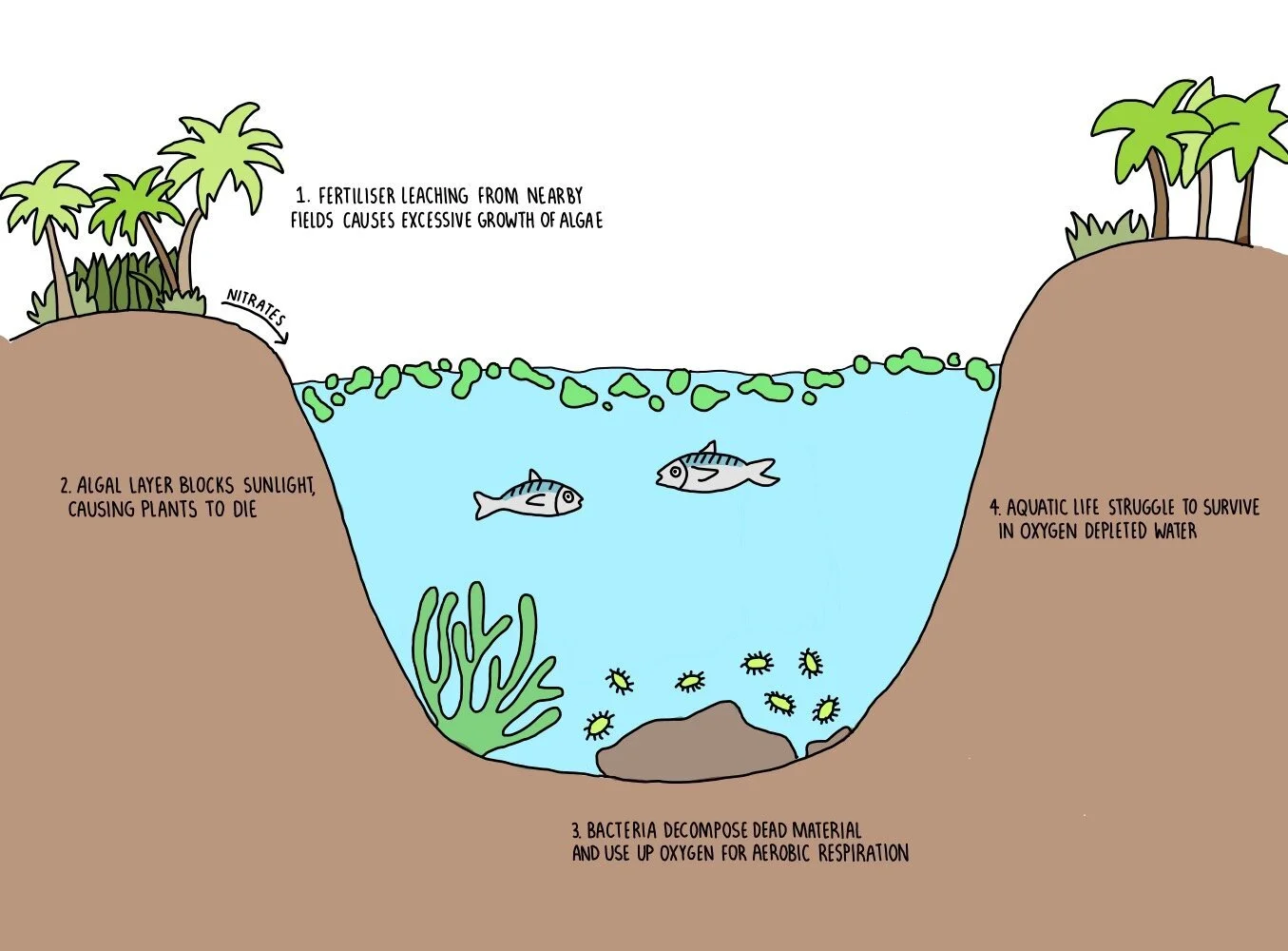Energy Transfers and Nutrient Cycles
Energy transfer through ecosystems
Energy enters the food chain when producers absorb light energy and convert it into chemical energy during photosynthesis. The energy is used for the plant for growth and becomes biomass (living matter). When primary consumers eat the plants, the energy (and biomass) is transferred to the next trophic level. The energy is eventually passed onto secondary and then tertiary consumers.
Only a small proportion (around 40%) of the energy at one trophic level is passed on to the next. The rest is lost in the following ways:
Not all the light energy that hits the plant will be absorbed - some will hit non-photosynthetic parts of the plant (e.g. the tree trunk). Of the light energy that does hit a photosynthetic pigment, not all of it can be absorbed because it is the wrong wavelength (e.g. chlorophyll pigments are unable to absorb green parts of the visible spectrum, which is why they appear green to us).
Not all parts of an organism are eaten e.g. bones, beaks and roots. The energy is transferred to decomposers.
Consumers may not be able to completely digest the organism - e.g. humans are unable to completely break down plant cell walls so it is converted into faeces. The energy is passed onto decomposers.
Of the 40% of total energy that is passed onto the next trophic level, only a quarter (10%) is converted into biomass and will be available to the next trophic level. The remaining 30% is used in respiration, movement and maintaining body temperature. This explains why food chains rarely exceed four or five trophic levels - there isn’t enough energy remaining by the time it is transferred to the tertiary consumer.
Measuring energy transfers between trophic levels
The official method of measuring energy transfers between trophic levels is to essentially roast the organisms in the oven to dehydrate them, weigh them and calculate the difference in mass between organisms at different trophic levels. That’s all fine for plants but not such a nice experiment where animals are involved. For this reason, scientists would usually estimate the dry mass of animals instead. Here’s the method anyway:
- Choose the area that you want to sample - e.g. a m2 area of woodland.
* Dry the different organisms in the food chain in an oven until their mass becomes constant - at this point you can be sure that all the water has been removed and you're left with only the dry mass (biomass). - Multiply the results of the sample by the size of the total area (e.g. to work out the biomass of that organism in 1500 m2 of woodland.
- The difference in biomass between the trophic levels is the same as the amount of biomass transfer (or energy transfer) between the organisms.
The limitations with this approach are that it assumes that each consumer only consumes one type of organism - it wouldn’t work for consumers which feed on multiple food sources.
Net Productivity
Biomass is the amount of energy that is available to the next trophic level - it can also be referred to as net productivity. You can think of this as the amount of weight an organism has been able to pack on - the fatter the organism, the more food (and energy) will be available for the organism that is going to eat it. Net productivity is calculated by taking the gross productivity (all the energy consumed by the organism) and subtracting the amount lost in respiration.
Whenever plants are involved, net productivity is referred to as Net Primary Productivity (NPP) because they are the first organisms in the food chain. It is calculated by taking the Gross Primary Productivity (GPP) and subtracting the energy used in plant respiration.
We can also calculate how efficient energy transfer is by dividing the net productivity by the total amount of energy taken in by the organism. This number is then multiplied by 100 to convert it into a percentage.
Food chains
We can use food chains to show which organisms feed on other organisms within an ecosystem and therefore the flow of energy from one organism to another. Energy always starts from the Sun and is converted into glucose by photosynthesis in green plants. Glucose is used in respiration to generate energy which is used to help the organism to grow (increase in biomass). Organisms which produce biomass by capturing the energy from sunlight are called producers and are at the beginning of every food chain. An organism which feeds on a producer are called primary consumers and will also be herbivores, since producers tend to be mostly green plants. The next organism in the food chain is the secondary consumer which will be eaten by the tertiary consumer.
Food webs
Food webs show the interaction of multiple interconnected food chains within an ecosystem. For example, in the marine ecosystem pictured below there are a number of food chains which are all connected together. You can see that if the population size of any of these organisms changes, it will affect all the other organisms in the food web. This is known as interdependence. For instance, if the number of squid in the ocean decreased, this would boost mackerel populations (as there are fewer squid to eat them) and reduce the amount of seaweed and red algae, since there are more mackerel consuming these plants.
Decomposers are also part of food webs. They break down dead material and allow nutrients to be recycled.
Farming practices
Farmers can increase the efficiency of energy transfer by reducing the amount of energy lost to other organisms (e.g. pests), through the following ways:
They may use insecticides to kill insects which feed on crops. Less biomass is transferred to the insect and plants grow larger (higher NPP).
Herbicides kill weeds which compete with crops. More water, mineral ions and sunlight can be obtained, increasing GPP and NPP.
Biological agents are natural ways of getting rid of pests. Parasites that live off pest species can be used to reduce their numbers, or pathogenic bacteria/viruses that infect pests are two biological ways of reducing pest numbers.
They can also increase the efficiency of energy transfer by reducing the energy lost in respiration:
Animal movement is restricted by keeping in pens and cages.
Animals are kept indoors or in heated environments so that less energy is used to generate heat.
Antibiotics are given so less energy is used to generate an immune response.
Decomposers
Microorganism such as bacteria and fungi are able to feed off and decompose dead organic matter - they do this by secreting digestive enzymes onto the organism. They digest the tissues of the dead organisms into smaller molecules, such as glucose which is absorbed externally by a process known as saprotrophic nutrition (organisms that do this are called saprobionts). Decomposers play an important role in breaking down waste products and enabling the chemical elements to be recycled.
Fungi form symbiotic relationships with plant roots. Fungi consist of long, thin strands called hyphae which connect to plant roots to form structures called mycorrhizae. This increases the surface area of the soil that the plant can obtain mineral ions from. This enables the plant to access more minerals and the fungi receives glucose (and other organic compounds) in return.
The nitrogen cycle
Plants can only absorb nitrogen in the form of nitrate so they depend on nitrogen-fixing bacteria to convert nitrogen in the air into nitrate in the soil. These bacteria either live freely in the soil or inside root nodules of leguminous plants (e.g. peas, beans). This is another example of a symbiotic relationship – the plant gets nitrates while the nitrogen-fixing bacteria get organic compounds like glucose.
The Haber process is used to convert nitrogen into ammonia which is used in fertilisers. Nitrifying bacteria convert the ammonium ions into nitrites which are then converted into nitrates, in a process called nitrification. Plants absorb the nitrates and incorporate the nitrogen into amino acids which are used to build proteins. The breakdown of proteins in our bodies produces urea which is removed from our body in our urine.
Another source of ammonia is the decomposition of dead matter by saprobionts in a process called ammonification. The ammonia is converted into ammonium ions in the soil.
In some conditions, denitrifying bacteria convert nitrates in the soil into nitrogen in the air. This usually happens in soil which is lacking oxygen (anaerobic conditions), such as waterlogged soil. Therefore, improving drainage can make soil more fertile by retaining more nitrates.
The Phosphorous Cycle
Organisms need phosphate ions to make phospholipids (for cell membranes), nucleic acids and ATP.
When rocks are eroded away, phosphorous is released from rocks into the soil in the form of phosphate ions. The phosphate ions can be absorbed by plants through their roots (or through fungal threads and passed onto plants in exchange for organic compounds). The plant uses the phosphate ions to synthesise nucleic acids and cell membranes.
When animals eat the plants, these structures are broken down and the phosphates used to build the nucleic acids, ATP and membranes within animal cells. Phosphate ions are released from animals in their waste products, which are released into the soil when saprobionts decompose urine and faeces.
Weathering of rocks also releases phosphates into ponds, rivers, streams and seas. Aquatic plants absorb the phosphate ions, which are passed along the food chain to sea birds. Guano is the phosphate-rich waste produced by sea birds and makes an effective natural fertiliser.
Fertilisers
When crops grow, they absorb and deplete minerals from the soil. Since the crops don’t die and decompose in the field, the nutrients aren’t returned to the soil by decomposers in the nitrogen and phosphorous cycles.
Farmers therefore replace the lost nutrients using fertilisers. These can be natural (e.g. manure, composted vegetables) or artificial (e.g. ammonium nitrate powder). Excessive use of fertilisers poses environmental problems, as they can leach into nearby ponds and rivers, leading to eutrophication.
Eutrophication
Fertilisers are used by farmers to add nitrates and phosphates to the soil. These inorganic ions are extremely soluble and are easily washed away from soil when it rains in a process called leaching. The rain containing dissolved nitrates makes its way into ponds and rivers where they are absorbed by algae causing a huge increase in algal growth. The algae can divide so rapidly that they completely cover the surface of the pond (known as algal bloom), blocking sunlight to plants growing at the bottom of the pond. The plants die because they are unable to photosynthesise and are decomposed by bacteria. The increasing bacterial population use up all of the available oxygen in aerobic respiration, reducing the amount of oxygen available for other aquatic organisms, which struggle to survive in oxygen-depleted water.
In natural fertilisers, the nitrogen and phosphorous are locked in organic molecules that need to be decomposed before the inorganic ions are released. This means that they are released more slowly into the soil and leaching is less likely.






